How to Choose the Best Wood Thickness Planer
A Woodworker’s Guide for Choosing the Best New and Vintage Woodworking Thickness Planer Machines
![]() By Joshua Farnsworth | Updated Feb 28, 2022
By Joshua Farnsworth | Updated Feb 28, 2022
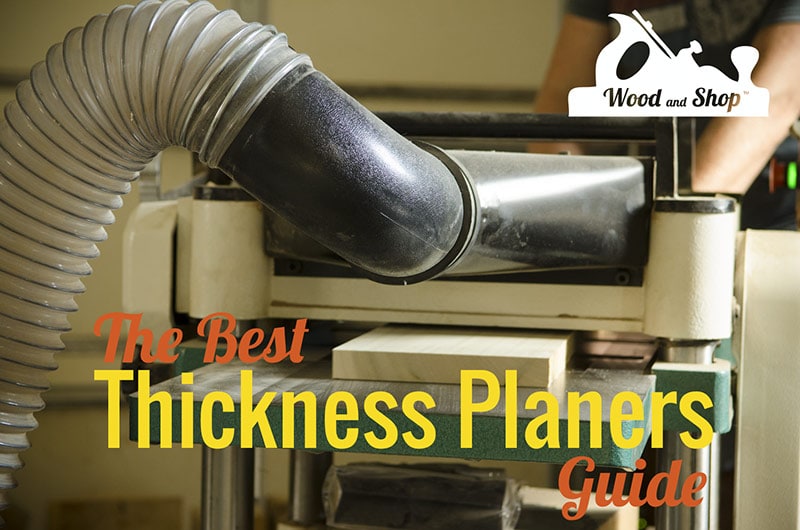
How to Choose the Best Wood Thickness Planer

A Woodworker’s Guide for Choosing the Best New and Vintage Woodworking Thickness Planer Machines
![]() By Joshua Farnsworth | Updated Feb 28, 2022
By Joshua Farnsworth | Updated Feb 28, 2022
Are you looking for advice to help you choose the best wood thickness planer for your money? In this article I’ll help you choose the best thickness planer for the money, whether you’re a beginner or an experienced woodworker.
How to Choose the Best Thickness Planer for Woodworking
What is a thickness planer used for? After you have flattened one face of a board on a power jointer, then that board can be taken to a thickness planer. The newly flattened board face is laid face down on the perfectly flat cast iron bed of a woodworking thickness planer. As you send the board through multiple times, the board is planed to a perfectly uniform thickness along the entire board.
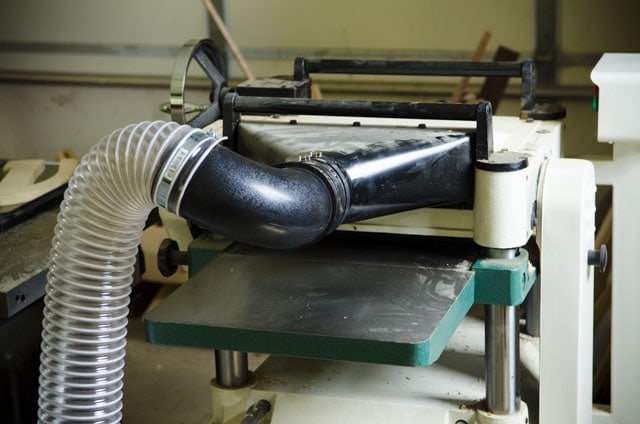
Some traditional woodworkers skip buying a power jointer (and flatten the first face and edge with hand tools) but still use a thickness planer. Why? Because getting a uniform thickness is harder than merely flattening one board face with hand planes.
Many woodworkers want to square up boards that are too wide for their power wood jointer, so they hand plane one face and edge with hand tools, and then send the wide board through their wider thickness planer.
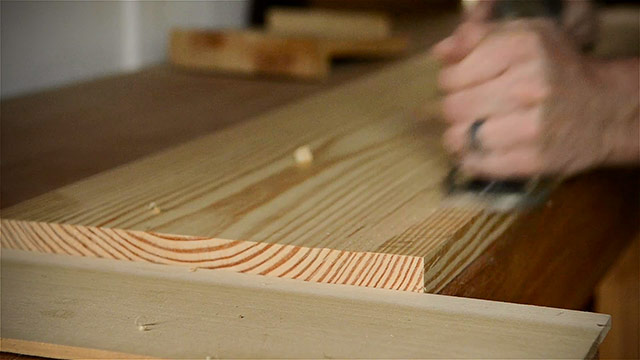
I wrote this article to be a valuable resource to woodworkers who are trying to find the best wood planer for their workshop. I have actually used many woodworking thickness planer machines in my lifetime, so this article shares a lot of real experience (from me and friends), rather than just pulling top Amazon sellers like other review articles. Now I’ll jump into discussing 6 important features to consider when looking to buy the best thickness planer for woodworking:
6 Features to Consider when Buying a Thickness Planer
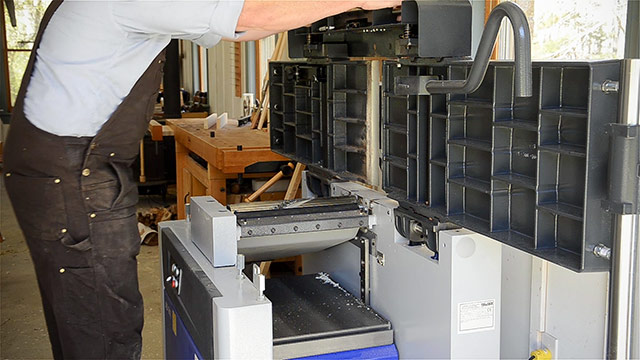
So what features should you consider when buying a thickness planer for your woodworking workshop? Certainly you want the best wood planer for your money. Much of my advice is similar to features that I mentioned in my previous article on choosing a power jointer, so you can refer to the jointer guide here. Alright, here we go:
1. Thickness Planer Style (benchtop vs. stand-alone vs. combo)
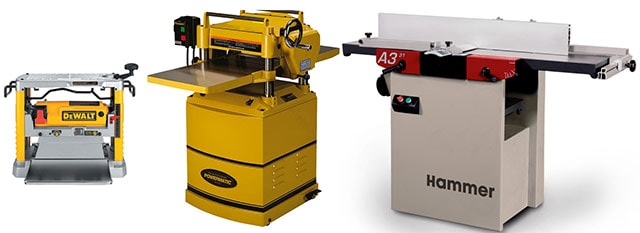
The first feature that I’ll talk about is the style of wood planer. Power thickness planers come in three different styles: benchtop thickness planer, standalone thickness planer, and combination thickness planer (that transforms into a jointer). Below I’ll briefly discuss the pros and cons of each style and in the last section of this article I’ll share some of the best thickness planers in each category:
Benchtop Thickness Planers
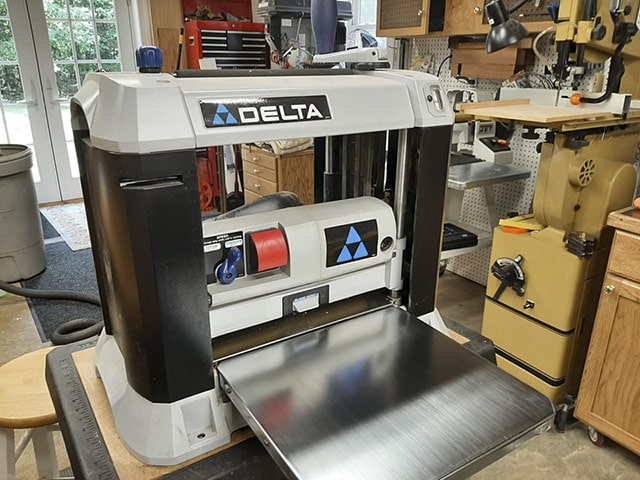
Benchtop wood planers are exactly what the name suggests: a thickness planer that is small enough to be used on your wood workbench. These are usually the more affordable style of wood planers, and I’ve owned and used a good number of these planers over the years.
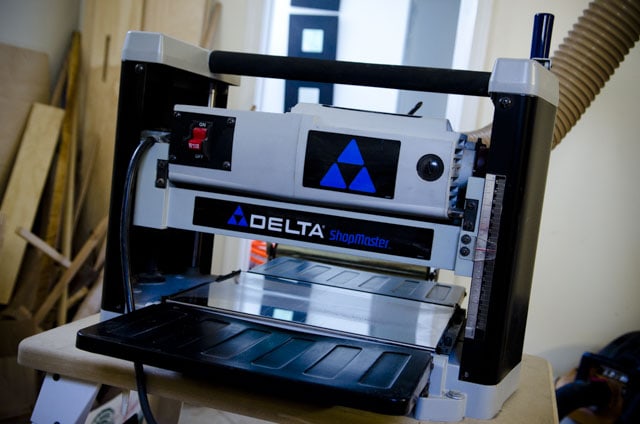
The bench top category is further divided into portable benchtop thickness planers (or “lunchbox planers”) and thickness planers that aren’t quite as portable. Portable thickness planers are designed to be taken onto a job site, as well as to be used in a workshop. Less-portable benchtop thickness planers are designed to take up less space in a workshop (on a workbench) but are bigger, heavier, and more robust.
Pros of benchtop thickness planers:
A benchtop thickness planer is usually less expensive than a standalone or combo thickness planer. And it is obviously easier to move from home to jobsite, or around your workshop.
Cons of benchtop thickness planers:
A benchtop thickness planer is usually underpowered compared with larger wood planers, which may make it difficult to thickness plane very hard and figured woods. Benchtop thickness planers come with the cheaper knife-style cutterheads, rather than a helical cutterhead (explained in section #5). A benchtop planer also may have inferior components and fewer features than a larger wood planer.
*Scroll down to this section to see the best benchtop thickness planers
Stand-alone Thickness Planers
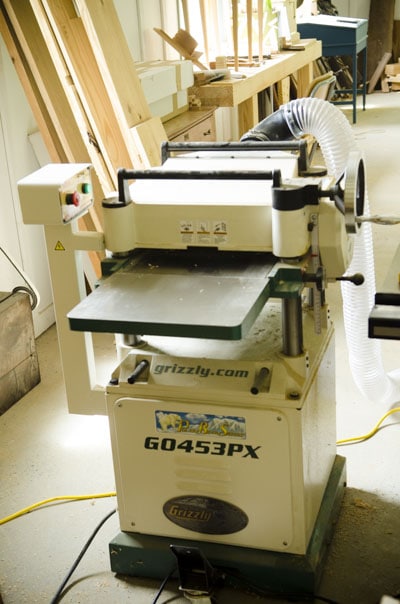
A stand-alone thickness planer is the name I give to a wood planer that has it’s own base and sits on the floor, rather than on a workbench top. Some people call it a “floor model planer”. This is the style of thickness planer that you’re most-likely to find in a professional woodworking workshop, and it’s the type I’ve had for years (until recently…I’ll talk about my upgraded combo planer / jointer below).
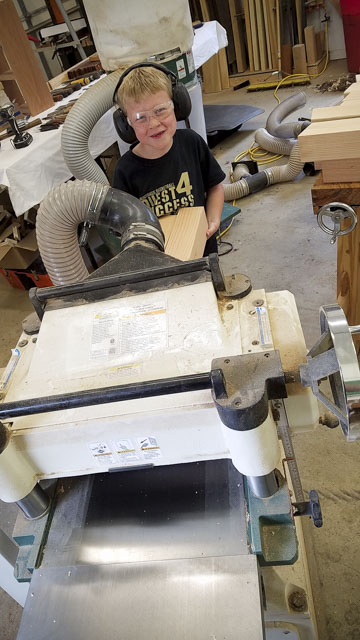
Why do professional woodworkers and serious hobby woodworkers usually prefer stand-alone thickness planers?
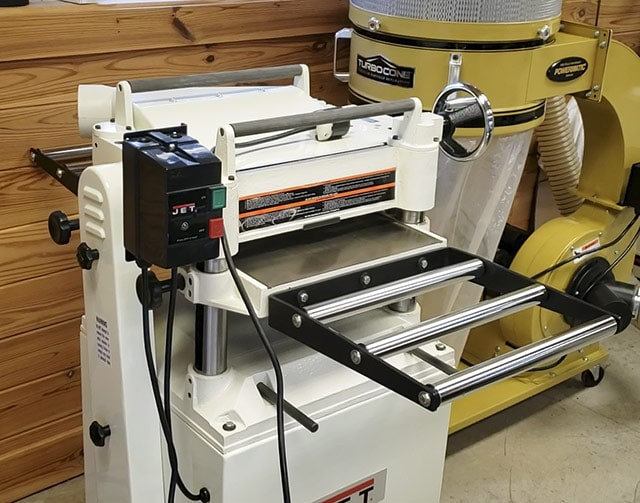
Pros of stand-alone thickness planers:
Because stand-alone wood planers (and some combo planers) usually have much more robust features than the benchtop planers, including wider cutting capacity, more powerful motors, longer and stronger infeed / outfeed tables, superior cutterheads, and more.
Cons of stand-alone thickness planers:
There are a few downsides of a stand-alone thickness planer. First, the cost is higher than a benchtop planer, and can be substantially higher. Also, this type of wood planer takes up a lot more space, which may not work in a smaller workshop. It also isn’t portable, for woodworkers or carpenters who want to take their planer to a job site.
*Scroll down to this section to see the best stand-alone thickness planers
Planer/Jointer Combo Machines
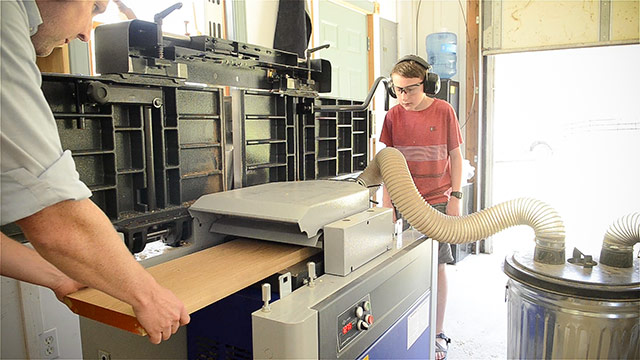
A combo planer / jointer machine is a woodworking machine that acts as a power wood planer and also converts into a power jointer. For workshops with limited space, some woodworkers have to make a compromise. A combination jointer/planer is one example of this type of compromise. Here’s a quick overview of how the process works: The board’s first face is flattened on the jointer, along with squaring an edge:
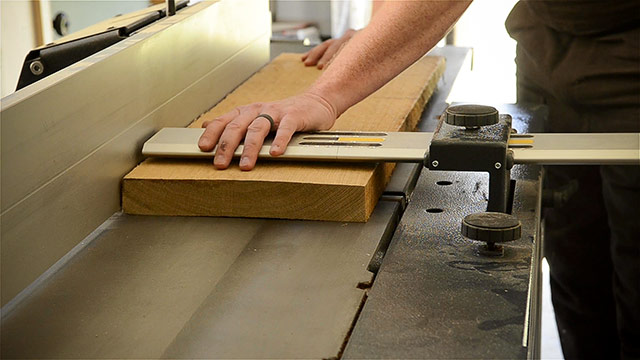
And then the jointer table is flipped up to reveal the thickness planer:

Let’s look at some of the pros and cons of this type of wood planer:
Pros of combo thickness planers:
As mentioned above, a combo planer / jointer machine is a great option for someone who wants the powerful features of a stand-alone wood planer and jointer, but doesn’t want to dedicate the space for those large machines. This is a major reason I upgraded to this type of wood planer / jointer. With so many workbenches in my woodworking school I needed a machine that took up a smaller footprint and was also able to be moved more easily around my workshop.
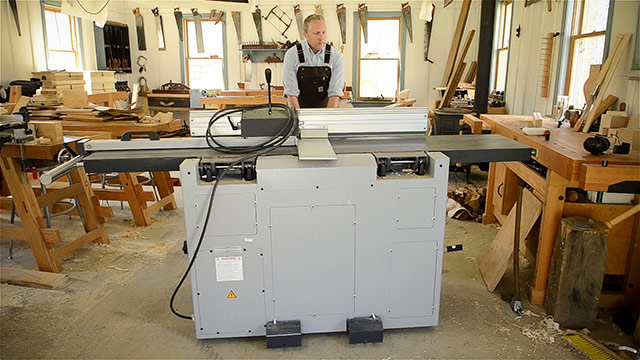
This type of jointer / wood planer also offers the ability to thickness plane wider boards, because the jointer has to be the same width as the planer. In my case, my old Grizzly standalone planer was 15-inches wide and my Grizzly jointer was 8-inches wide. But now, with my Felder AD 941 machine, the jointer handles 16-inch wide boards as does the thickness planer.
Cons of combo thickness planers:
Probably the biggest downside is that a combo machine requires switching the machine back and forth between jointer and thickness planer. If you’ve got a production shop where multiple people will be jointing and planing at the same time, then this might be an inconvenience when compared with owning two separate machines. It’s not much of a convenience for me, but I can see how it would be in a production shop.
The shorter beds on some combo machines may not allow for as much support, and while you would get a wider jointer than normal (12-inches wide is common) the planer would be the same size, and 12-inches is more narrow than many planers, like my old 15-inch stand-alone planer. So I recommend buying jointer / planer combo machines with 16-inch beds or larger. And a 16-inch jointer/planer combo would handle almost any project you may have. But if you don’t plan on thickness planing boards wider than what you joint, this isn’t an issue.
Here is a video that I created about my Felder AD 941 jointer / planer combo machine so you can understand how higher-end combo planer / jointers can be an amazing solution:
2. Thickness Planer Size / Capacity
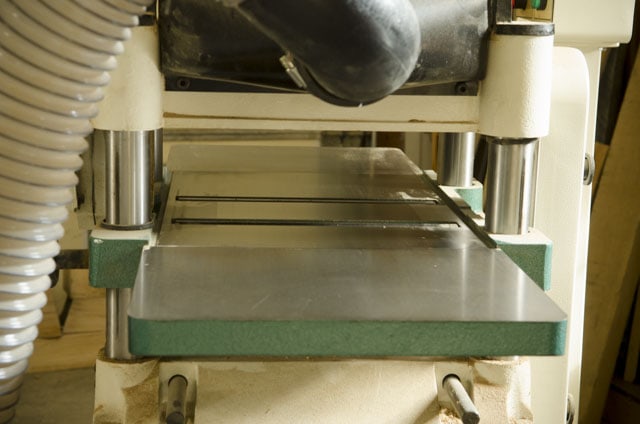
The planing width of thickness planers is a really important feature to consider when buying a wood planer. Most benchtop model thickness planers will only allow for about 12-13-inch wide boards, which I find limiting because I like to build furniture with wider boards so I don’t have to do so much gluing & clamping.
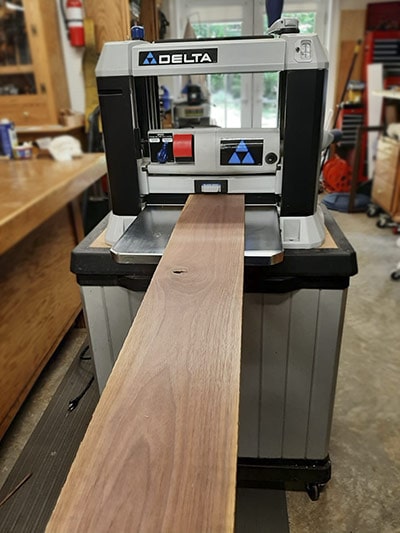
The larger thickness planers typically run in sizes from 15-inches wide up to around 25-inches wide. Both the stand alone thickness planers and the combo thickness planers come in wider sizes. Years ago when I upgraded from a 12-inch wood planer to a 15-inch wood planer, it was a game changer. Now I have a 16-inch Felder thickness planer, and it’s amazing what boards I can plane.

I really haven’t ever run into a situation where I wanted to plane a board wider than 16-inches. So thickness planers in the 20-inch to 25-inch range are overkill for most woodworkers. And if you don’t plan on thickness planing wider boards at all, or your space is limited, then a benchtop thickness planer with a 12 or 13-inch width will work for you. And in this guide I won’t discuss the height of the planer bed, because it’s very rare that someone will need to plane a very thick board.
3. Thickness Planer Horse Power
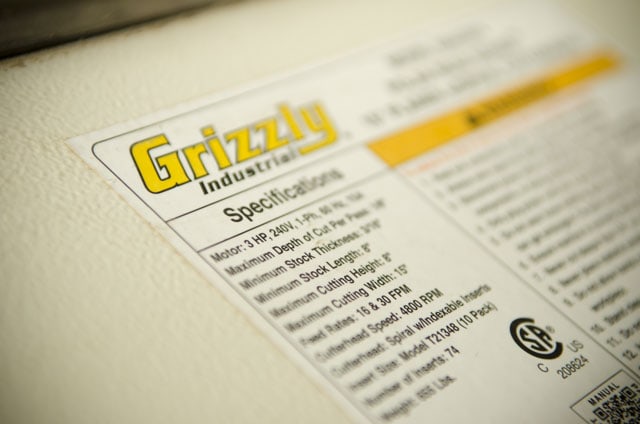
Larger thickness planers have more powerful motors, compared with some benchtop planers. Higher horse power allows for more wood removal and faster wood removal when thickness planing. I personally don’t have a problem taking more passes with lighter cuts, because wood tends to tear out more when taking a heavy cut. So the limited cutting depth of a benchtop model wouldn’t bother me. But higher motor horse power also makes it easier to plane harder woods, like tropical woods, that may bog down a thickness planer with a weaker motor. A thickness planer with a higher horse power also makes it easier to plane wider boards, or multiple boards at the same time.
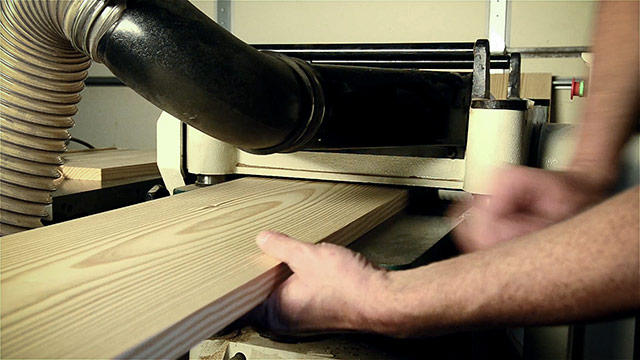
I have found that a 3 HP motor on a thickness planer rarely has any difficulty with thickness planing anything in my workshop. Most upper-end woodworking thickness planers come in a 3HP to 5HP range. But if you don’t mind keeping your thickness planing slowed down, and you will mostly use non-tropical hardwoods and softwoods (i.e. not super hard wood), then a benchtop thickness planer with slightly lower horse power (like this popular Dewalt dw735 thickness planer with 2.17HP) should work great. It’s also important to note that professional level thickness planers (like mine that I feature in this article) often don’t display a horse power rating. I’m pretty sure that “horse power” is a term more used on consumer-level machinery to assist woodworkers in comparing machinery.
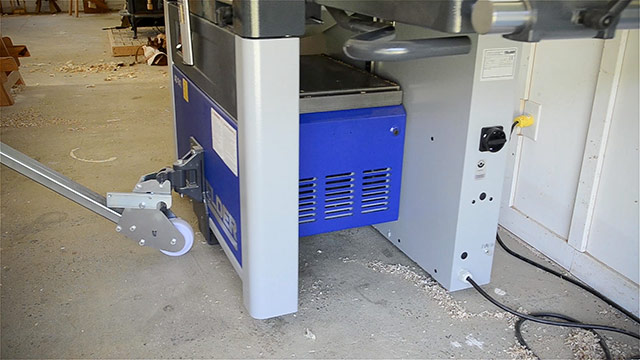
So if you’ll be doing occasional thickness planing, then you can look for thickness planers under 3HP. For serious thickness planing, stay with machines over 3HP. And if you buy a professional level thickness planer, don’t worry about HP. It’ll handle mostly any thickness planing job.
4. Thickness Planer Table Support
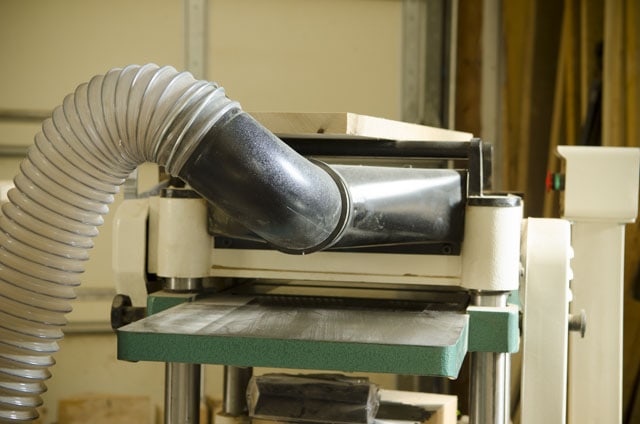
Larger thickness planers (both stand alone planers and higher end combo thickness planers) can have very strong and long cast iron beds and infeed and outfeed tables, which are required for thickness planing heavy pieces of lumber. The length of the bed also gives better support for any size of lumber. Benchtop models usually have rather weak infeed and outfeed tables, which can’t handle heavy pieces of lumber, and which are more difficult to make dead flat. This can lead to more serious thickness planer “snipe” on your boards.
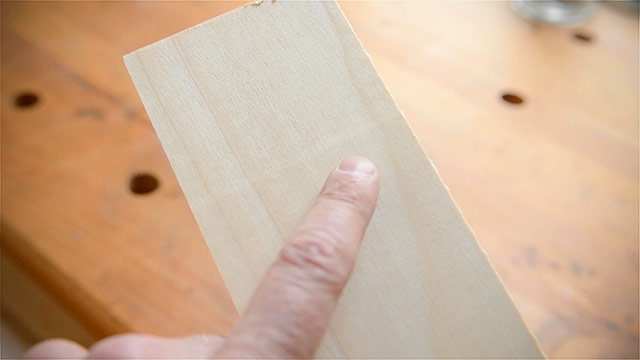
Thickness planer snipe is where the cutter head takes off too much wood on the first 3-5 inches and last 3-5 inches when the feeder grabs the board. It’s caused by not having good enough support on the infeed or outfeed tables (or no infeed or outfeed tables at all). Snipe can be frustrating because you either have to cut off those ends, or take the board back to the jointer and flatten the face with the snipe. My Felder AD-941 planer / jointer combo machine has such a strong, long, and precision-made bed that I don’t get snipe on my boards.
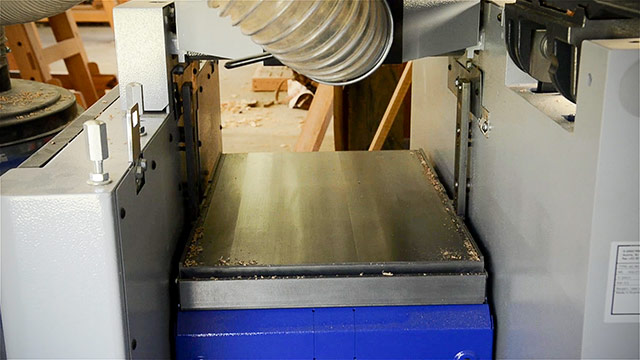
But if you can’t afford a high-end professional thickness planer, don’t fret. There are some ways to reduce or prevent thickness planer snipe. Here’s a video that shows some common tricks to reduce snipe, especially on benchtop thickness planers. This guy is using what is considered the best benchtop planer, the Dewalt 735 thickness planer (which you can find the best price here).
5. Thickness Planer Cutter Head Style
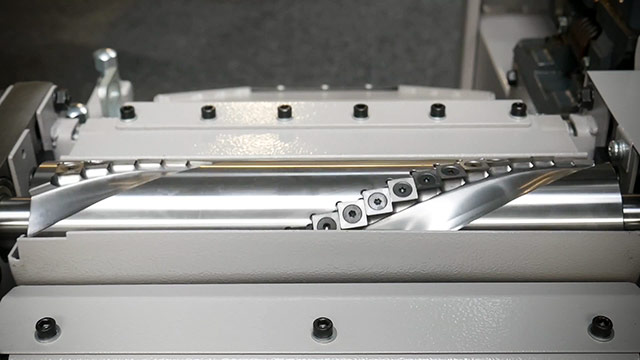
Thickness planers come with two different types of cutterheads, ones with straight knives that run the length of the cutterhead, and helical cutterheads (sometimes called “spiral cutterheads”). To me this is a major consideration when choosing the best thickness planer.
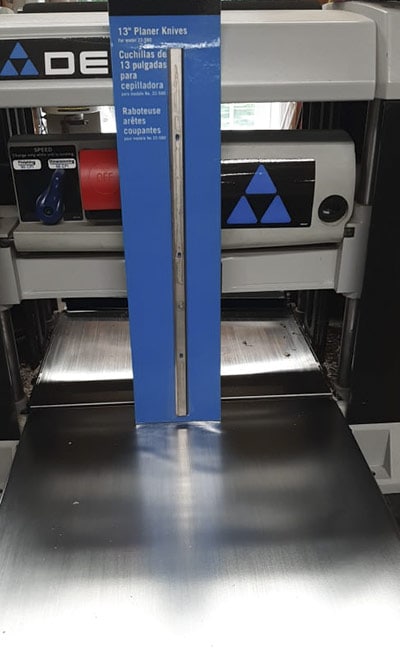
For years I struggled with the old style of cutterhead that had three long knives. Not only were the knives frustrating to change and align, but the finish on the board was inferior, especially on figured wood. I know, I know. A thickness planer isn’t for getting a finished surface. That’s what hand planes and sandpaper are for. But with a knife cutterhead, tearout was just expected, especially on figured wood. But then helical cutterheads were introduced, and my world changed–at least in relation to milling up lumber.
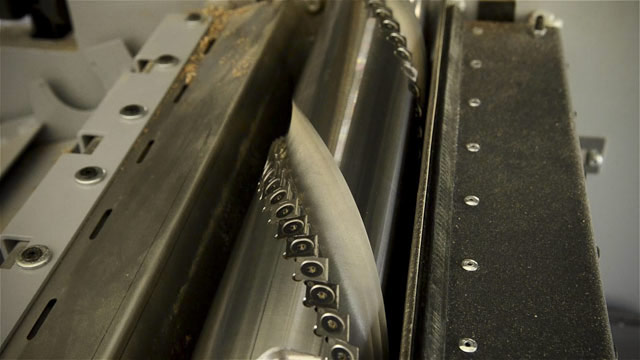
The helical cutterheads (on both my jointer and thickness planer) gave my boards a smoother finish, with almost no tearout, even on figured boards or dense hardwoods. This led to less time spent handplaning and sanding. And because a helical cutterhead uses small square carbide cutters, the process of changing a chipped or dull blade became much, much easier. You just rotate one little blade 90 degrees rather than replacing or resharpening the whole HSS knife. Additionally, carbide cutters maintain a sharp edge substantially longer than the traditional straight knife cutters.
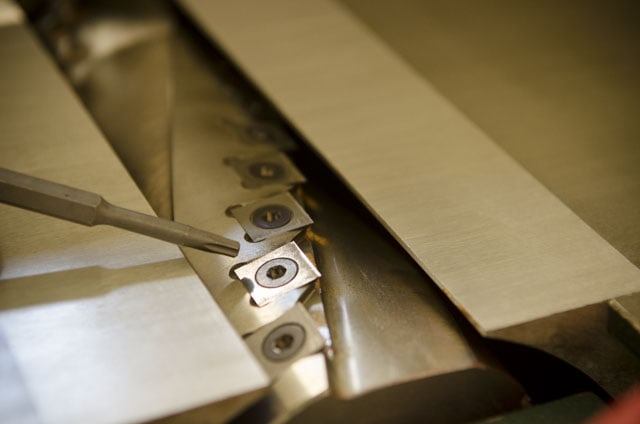
A helical cutterhead / spiral cutterhead is also quite a bit quieter than the traditional knife cutterheads. Now I’m not saying they’re quiet, just more quiet.

I don’t know of any benchtop thickness planer that comes with a helical cutterhead. To keep the price low, the manufactures use cutterheads with three knives (and sometimes 2 knives in cheap models). Fortunately some benchtop planers allow for the addition of a spiral cutterhead. But just be prepared because the cutterheads run about $500. As I mentioned elsewhere in this article, this Dewalt dw735 benchtop thickness planer is considered the best benchtop thickness planer on the market. Because the Dewalt 735 is considered the best, there are more helical cutterhead options. Here you can find helical cutterheads made especially for that wood planer. But I would advise you to purchase the Byrd Tools Shelix helical cutterhead. Byrd helical cutterheads are widely considered to be the best available replacement cutterheads. The way Byrd sets the angle cutter angle produces a shearing action, which gives a finer finish than the Grizzly cutterheads, for example.
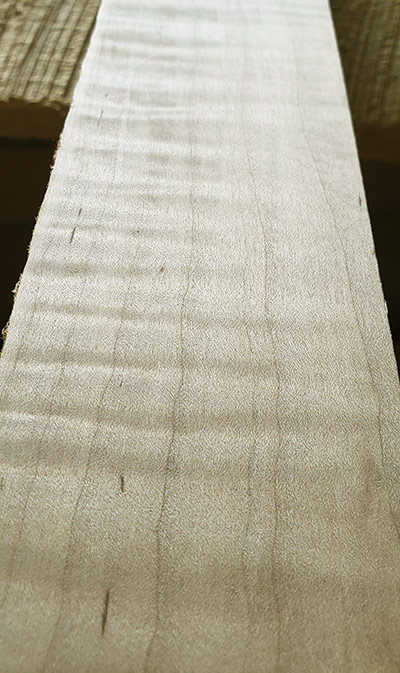
And just so you know, every other manufacturer charges extra to include helical cutterheads on their machines, whether it’s a stand alone thickness planer or a combo planer / jointer. So just be prepared to pay more if this is an important feature to you. But please take my word for it. Having a helical cutterhead is definitely worth an extra $500. In my opinion, not having a helical cutterhead is a major drawback.
*Note: some high-end thickness planers do have knife cutterheads that are quick and easy to change the knives on.
6. Buy a New Thickness Planer or a Used Thickness Planer?
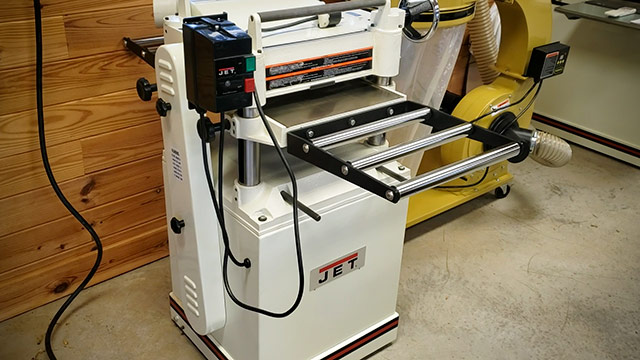
So should you buy a new thickness planer or a used thickness planer? The answer is that it all depends on a few factors. First it’s important to understand that not all used power wood planers are the same. Just like buying a used car, you can get a lightly used thickness planer, and you can get a lemon that has too many miles and too much abuse. Here are two examples: I was recently helping a lady sell a workshop full of woodworking machines and tools that belonged to her recently-deceased father. His thickness planer (like all of his woodworking machines…pictured above) looked as if they hadn’t been used at all. In nice workshops like this you can usually get a really great used thickness planer. However, I’ve seen some thickness planers (and other machines) that have been neglected, and even used and stored outdoors. Of course, they had a lot of rust!
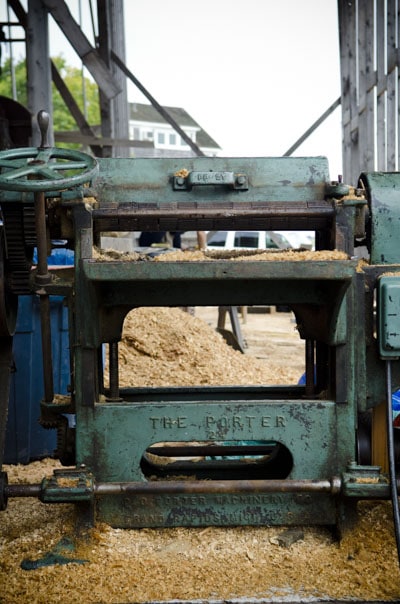
Inspect the used thickness planer to look for rust pitting and any loose parts. Also, just because a used thickness planer looks new, doesn’t mean it’s a good wood planer. Just like with a car, see if you can take a “test drive” with the used wood planer. Run a few figured boards through it to see how it handles and if you can spot any problems. If the seller won’t let you try the planer out, then move along.
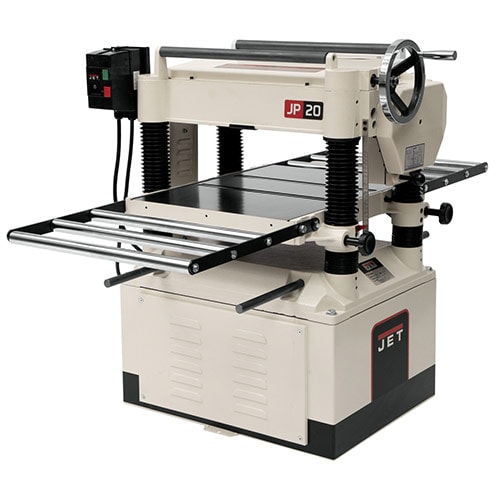
Now let’s talk about buying a new thickness planer. When buying new, you may not feel like you’re getting a great “deal”, but you usually get more peace of mind with a warranty and no rehabilitation work. And you can just get planning your wood on day one. Changing blades on a used thickness planers is a real pain in the butt, so it’s nice to fire up a brand new thickness planer.
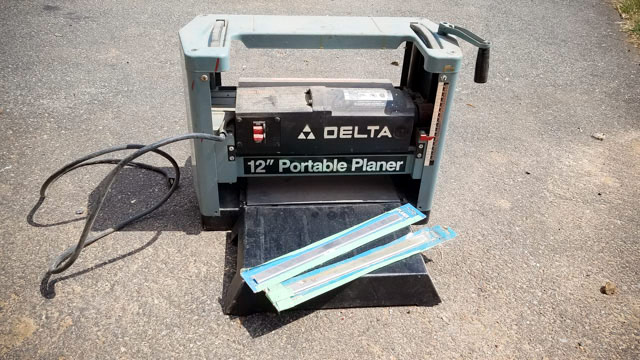
You can find great thickness planers that are both new or used, and you can also find bad thickness planers that are both new and used. Aside from inspecting the planer and trying it out, do some research on the brand and model before you even make the trip to look at the wood planer. Some manufacturers that previously made high-quality tools may have dropped their quality on their newer machines. Knowing details like this will save you a lot of time and money.
Vintage thickness planers were certainly well built, and usually last longer than new thickness planers. However, an old thickness planer may require quite a bit of time to clean and get it working. And vintage thickness planers won’t have a helical cutterhead, and likely won’t even be compatible for a replacement helical cutterhead. To me that’s a big deal.
But if you don’t mind using the old style knife cutterheads, and you like rehabbing machinery, then a vintage thickness planer will work great for you. But if you don’t want to spend time rehabbing an old machine, and you like the idea of having a helical cutterhead, then go for a new thickness planer or a used thickness planer that is more modern.
What is the Best Wood Planer?
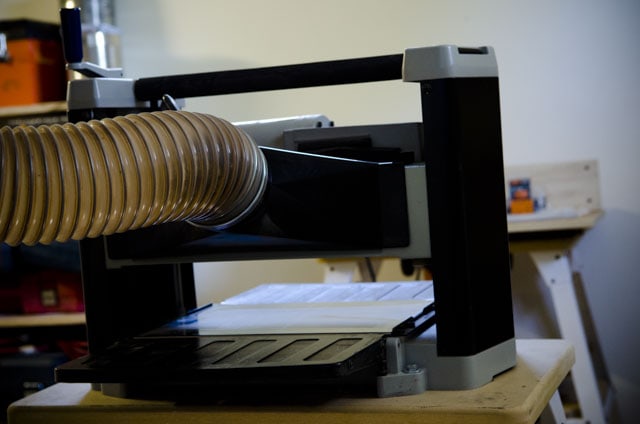
Power thickness planers come in different styles: benchtop thickness planers, standalone thickness planers, and combination thickness planers (that also transform into a jointer). Below I’ll briefly discuss the pros and cons of each style and share some of the best thickness planers in each style:
Best Benchtop Thickness Planers
There are quite a few benchtop thickness planers on the market, and many are available to purchase online because of their smaller size. Most of them fall short of being considered the best portable planer. Here are a few of the best benchtop planers on the market (in my opinion):
Dewalt dw735 Benchtop Planer:
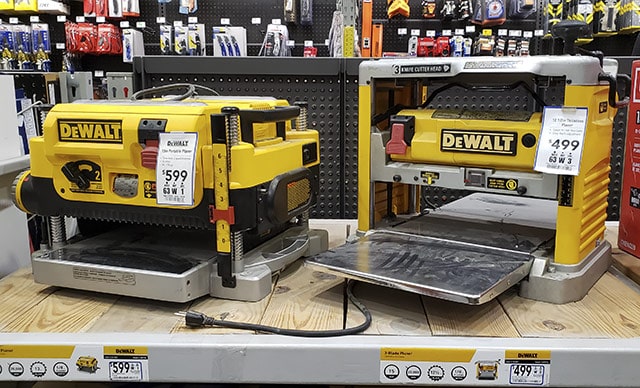
The Dewalt dw735 thickness planer is the most popular wood planer in the benchtop category. Dewalt has been making versions of this thickness planer for many years. A version of the Dewalt 735 was one of the first thickness planers that I used. The Dewalt DW735 and Dewalt DW735X both feature a 2-speed gear box, a more rigid cast aluminum base, and a 13-inch capacity, which is an inch wider than many other benchtop thickness planers. The Dewalt DW735X is simply a version that comes with an infeed table, outfeed table, and extra blades. Both the Dewalt DW735 and the DW735X have a fairly powerful 15 amp motor that has about 2.17 HP. That’s good for a benchtop planer. Both machines run about $599. They are the same machine, and for the same price you can get the DW735X with the extras, so I’m not sure why you wouldn’t go with that deal. I think they just sell more of the DW 735X, so the price has dropped.
Dewalt also makes a more portable version of this planer, which is the Dewalt DW734 (pictured above on the left). I haven’t used DW734, but it has good reviews. Here are a few places you can check prices on these Dewalt thickness planers:
- See Dewalt DW735 and DW734 planers at Amazon
- See Dewalt DW735 and DW734 planers at WoodCraft
- See Dewalt DW735 and DW734 planers at Rockler
Makita 2012NB 12-Inch Planer:
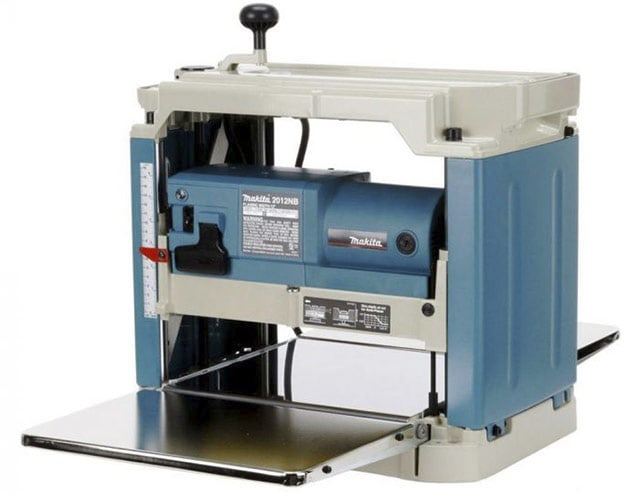
Makita is a brand name that I’ve trusted for many years, and this portable Makita 2012NB thickness planer is another good option if you want to stick with a portable thickness planer. Some woodworkers feel like this Makita planer has fewer quality issues than the DeWalt planers. This planer is more of a benchtop planer that you would see on jobsites. The 15 AMP motor is quieter than most other benchtop thickness planers, and it has solid infeed and outfeed table included, which tends to lead to less snipe issues than other benchtop planers. The price tag is quite a bit higher than the DeWalt planers, at around $750.
Best Stand-alone Thickness Planers

A stand-alone thicknes planer is the name I give to a wood planer that has it’s own base and sits on the floor, rather than on a workbench top. Some people call it a “floor model planer”. This is the style of thickness planer that you’re most-likely to find in a professional woodworking workshop, and it’s the type I’ve had for years (until recently…I’ll talk about my upgraded combo planer / jointer below). Why do professionals and serious hobby woodworkers prefer stand-alone thickness planers?

Because stand-alone wood planers (and some combo planers) usually have much more robust features than the benchtop planers, including wider cutting capacity, more powerful motors, longer and stronger infeed / outfeed tables, superior cutterheads, and more.
So what is the best wood planer in the stand-alone style? I can’t say which is the best wood planer for you, because that depends upon how you work wood and what size your shop is. But I will share some of the top hobbyist / professional thickness planer brands below:
Felder / Format 4 / Hammer thickness planers
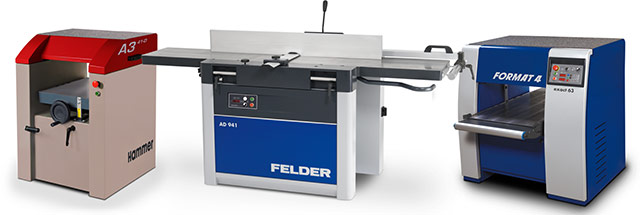
The Felder group manufactures several lines of top woodworking machinery, and has an excellent selection of stand-alone wood planers and combo planer/jointer machines. I own a Felder Jointer-Planer, which I will talk about in the next section on combo planers. Felder’s highest end production-quality brand is Format 4, followed closely by the Felder brand, and their small pro shop / consumer brand: Hammer. The Felder Group is based in Austria, and they manufacture truly amazing woodworking machines that are known for their engineering, precision manufacturing, and well-thought-out features. Even their consumer Hammer brand is well-made, and has high-end parts and options, like planing widths up to 16-inches. You can see thickness planers and pricing from all three product lines here:
Martin / Robland thickness planers
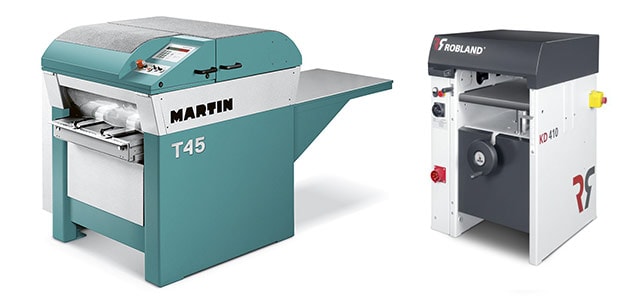
Martin is another brand of fine woodworking machinery that you’ll often see in production shops. Their wood planer tool lines are the Martin machines and Robland machines (among other brand names for other machine types). The Martin brand is on a similar level as the Felder and Format 4 brands (mentioned above) and is out of most woodworker’s budget. The Robland brand is a more affordable line of machines (similar to Felder’s Hammer brand) that Martin imports from Belgium. I haven’t used a Martin or Robland planer, but have heard great things about the machines. You can see all the wood planers and pricing at the Martin website:
Powermatic thickness planers
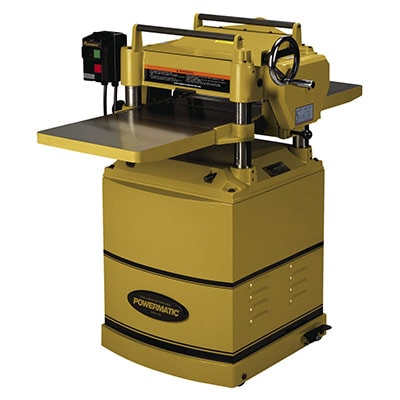
Powermatic has been a well-respected brand name among the companies that manufacture machinery for pro woodworking shops and hobbyists with money to spend. The mustard yellow machinery told other woodworkers that you were serious about making furniture or musical instruments. While there are still plenty of satisfied woodworking customers, I started to hear grumblings among woodworking consumers a few years ago due to a possible lowering in manufacturing quality control. Powermatic woodworking machines used to be manufactured in the U.S.A. but after being acquired by the company that makes JET woodworking machinery, many customers have complained about a decline in quality control. Not all of them, but some of them. This may be some research that you’ll need to do for yourself if you’re looking to buy a newer Powermatic planer. You can read a good forum thread about it here to help you make a decision.
- View Powermatic planers and pricing at WoodCraft
- View Powermatic planers and pricing at Rockler
- View Powermatic planers and pricing at Amazon
Oliver thickness planers
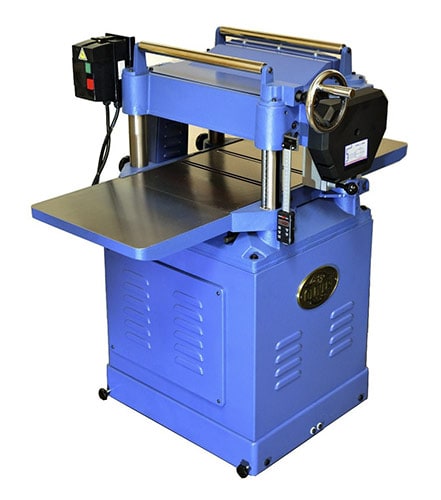
Oliver is a higher-end consumer / pro workshop brand of woodworking machinery. Oliver carries a large range of wood planers, running all the way from a $900 “lunch box” benchtop planer to a $14,000 production 25-inch planer with Byrd Shelix cutterhead. I haven’t tried an Oliver planer, but I do personally own a Oliver hollow chisel mortiser machine and can tell you that the quality is top-notch.
Laguna thickness planers
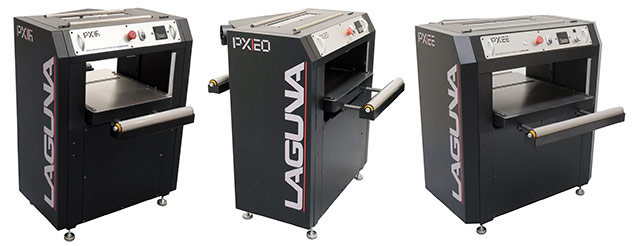
Laguna has traditionally been a manufacturer of higher-end woodworking machinery, and in addition to their portable benchtop planer (see it here) they have a line stand-alone wood planers that range in bed size from 16-inch to 22-inch, with horse power between 5HP and 10HP. That’s serious power. Prices range from $3,750 to $7,350. And their largest 22-inch planer comes in both 1-phase and 3-phase electrical wiring. I haven’t used a Laguna thickness planer, and don’t know anyone else who has, so I’ve included a forum user review of the 16-inch Laguna wood planer here to help you in your research if a Laguna planer interests you.
- View Laguna planers and pricing at WoodCraft
- View Laguna 16-inch ShearTec II 5HP planer and pricing at Rockler
- View Laguna 22-inch ShearTec II 7.5HP planer and pricing at Rockler
Grizzly thickness planers
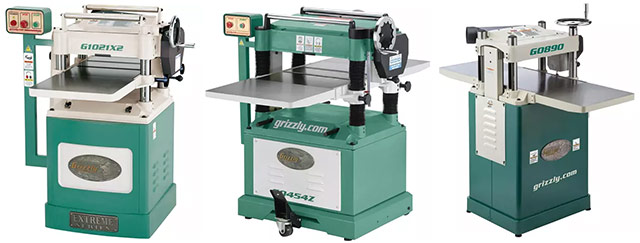
Grizzly manufactures a large range of benchtop and stand-alone thickness planers and jointer-planer combo machines. These machines are made in Taiwan, and are pretty good quality. For about 5 years I had a 15-inch Grizzly thickness planer with a spiral cutterhead and a 8-inch jointer. I had a pretty good overall experience with the planer (not so much the jointer) before upgrading to a Felder jointer-planer machine. You’ll see some photos of my Grizzly planer throughout this article.
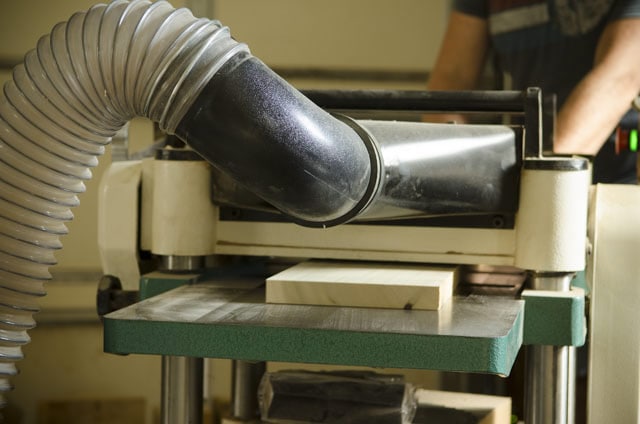
My Grizzly G0453PX Planer (see it here) had a 15-inch wide planing bed, which was suitable for most projects. It’s 3HP motor was strong enough for any boards that I sent through it. And I planed thousands of board feet of lumber with this thickness planer and haven’t experienced any notable problems. The mobile base was the only real complaint that I had, as it eventually lost hold and would slam down every time I put it down. This same issue eventually happened to my Grizzly jointer too. The cast iron tables were very supportive, and the spiral cutterheads left a nice surface with minimal machine marks and very little tearout (only a little on highly figured wood). Another complaint was that as hard as I tried I couldn’t adjust the infeed and outfeed table to get rid of snipe. But overall it was a good thickness planer. You can see Grizzly’s wide range of planers here:
JET thickness planers

Jet is a mid-level woodworking machinery company that makes fairly good wood planers mainly for hobbiest woodworkers. They do make some planers that get into the 20-inch range and run from about $1,800 to $4,000. I have used JET thickness planers in friend’s workshops, and they seemed to work fine. However, the same quality control issues that I mentioned above for Powermatic planers applies to JET. It makes sense, because they are manufactured by the same company.
Best Planer/Jointer Combo Machines

As I mentioned in the earlier section on combo planers, they are a great way to save space in your workshop without compromising performance…as long as you get one that is high quality. Here are some options for my favorite combo planer / jointer:
Felder Planer & Jointer Combo Machines
For many years my dream woodworking machine was the Felder AD 941. Now I own one, and I love it. It has saved me a lot of space in my workshop, and it allows me to joint and plane huge boards, up to 16-inches wide. You can read my article & see my video about it here.
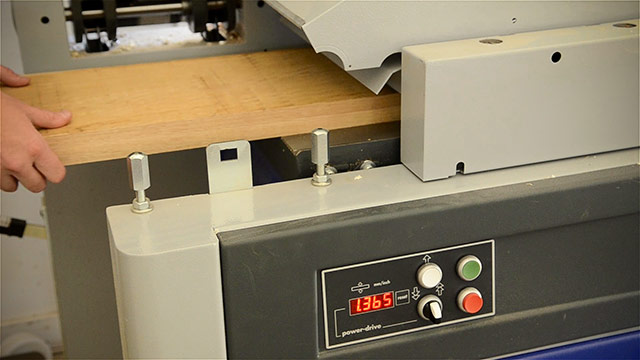
The helical cutterheads leave my figured boars beautiful, with no tearout and minimal machine marks. And planer snipe is a thing of the past for me because of the solid cast iron table. You can see the Felder AD 941 16-inch jointer/planer machine here. Felder also makes a 20-inch machine (the Felder AD 951) which goes beyond my needs. These machines have incredible tolerances and accuracy. The 16-inch Felder starts at around $11,500, but it’s still less expensive than buying a separate 16-inch jointer and large thickness planer from companies like Grizzly (the maker of my former jointer and thickness planer). And the quality is higher than Grizzly. You can see some of the Felder woodworking machines here and you can watch their video featuring their different planer / jointer machines:
Hammer Planer & Jointer Combo Machines
Felder also makes the “Hammer” series of jointer/planer combos that are more than enough for most small-shop professional and hobbyist woodworkers, and less than half the cost of the Felder line.
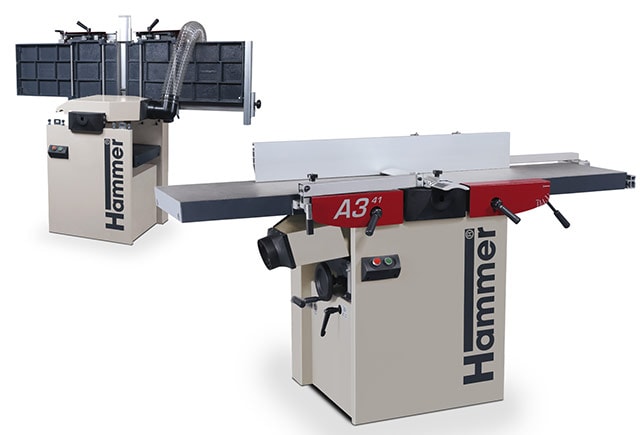
You can see them here. They also come in planing widths up to 16-inches, so it’s a more affordable option for jointing and thickness planing wide boards. The Hammer planer / jointer machines are one of my top recommendations because they are cheaper than buying both a stand-alone jointer and planer of any other brand in this size. You can see the two models here:
- Hammer® A3-26 ($4,612)
- Hammer® A3-31 ($5,212)
- Hammer® A3-41 ($6,984)
I have also heard that Minimax makes good high-end jointer / planer combo machines, though I haven’t tried them. And here are some more affordable hobbyist jointer/planer combo woodworking machines that you can check out at:
- Rikon 12” Planer / Jointer at Rockler Woodworking
- Jet® 12” Planer/Jointer Combo w/Helical Head at Rockler Woodworking
- JET 708476 Model JJP-12HH 12-Inch Planer/Jointer with Helical Cutterhead at Amazon
- Grizzly G0634Z 12-inch Planer/Jointer with Spiral Cutter head at Amazon
- Minimax jointer / Planer machines
Conclusion on Choosing the Best Thickness Planer
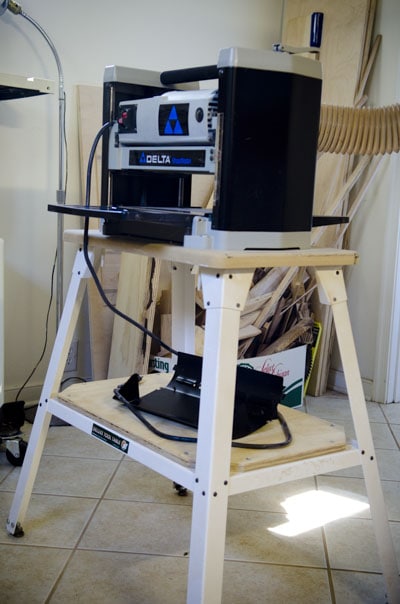
So to summarize this article I would say that the type of thickness planer that is best for you is one that fits in your workshop, that has the power and features to accomplish the kind of wood you want to thickness plane, and that fits within your budget. I hope this article has helped you to find the best thickness planer for you, and that meets those criteria for you. Please comment below if you have any questions or if it seems like I neglected to include any information or top thickness planer brands in this Power Tool Woodworking Buying Guide on thickness planers.
TOOL GUIDE SHORTCUTS:

HAND TOOL BUYER’S GUIDES
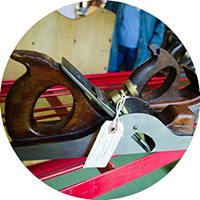
- Intro to Buying Woodworking Hand Tools
- Workbench & Tool Storage
- Layout, Marking, & Measuring Tools
- Handplanes
- Handsaws
- Chisels
- Sharpening & Honing Supplies
- Mallets & Hammers
- Hand Drills, Braces, & Bits
- Tools for Curved Work
- Tools for Green Woodworking
- Woodworking Clamps, Gluing & Fasteners
- Tools for Wood Carving
- Products for Wood Finishing, Sanding & Scraping
- Wood Turning Tools & Lathes

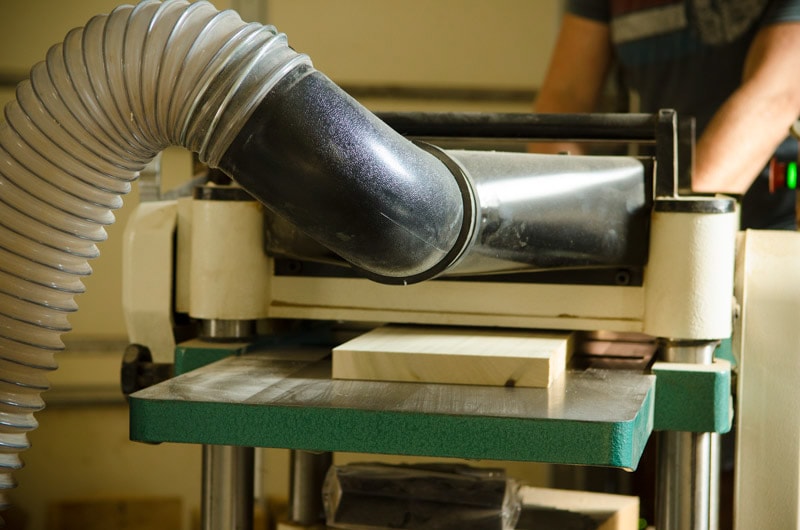
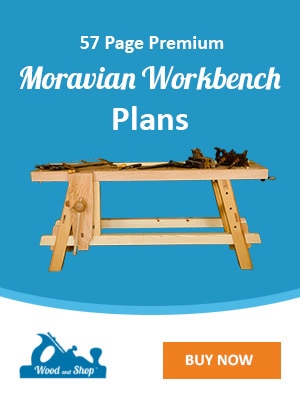
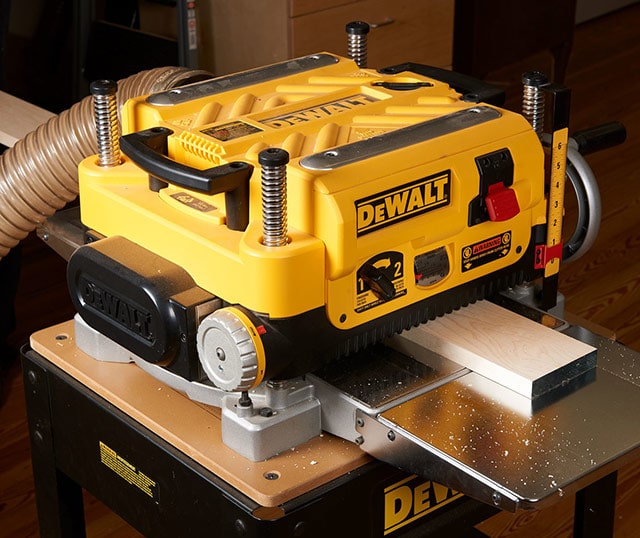
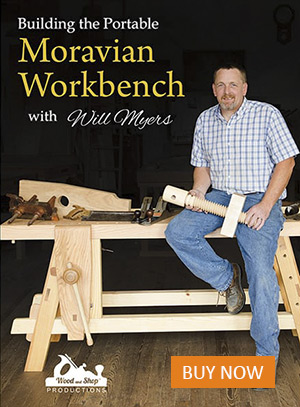
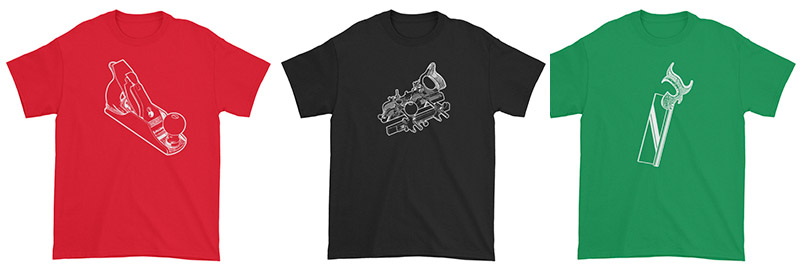
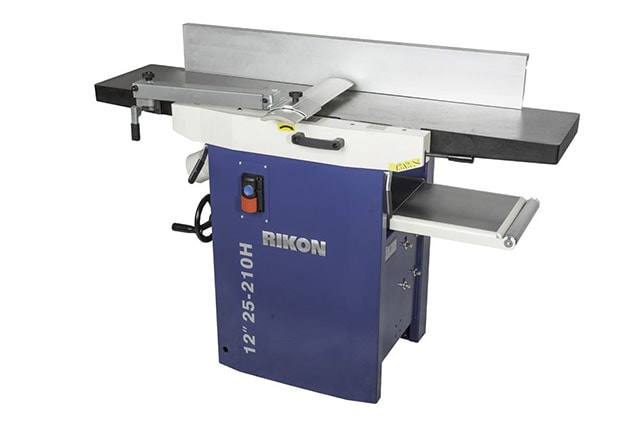
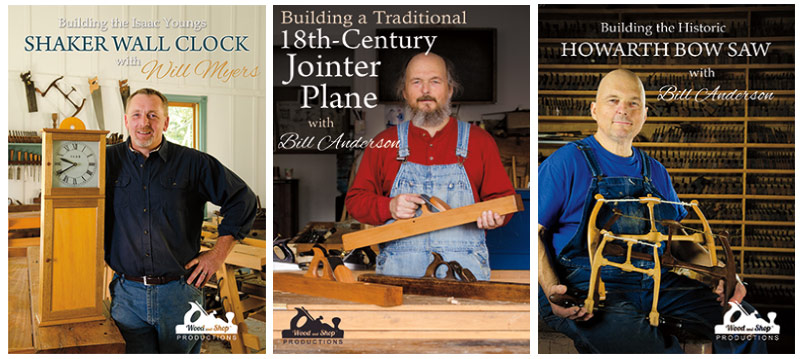
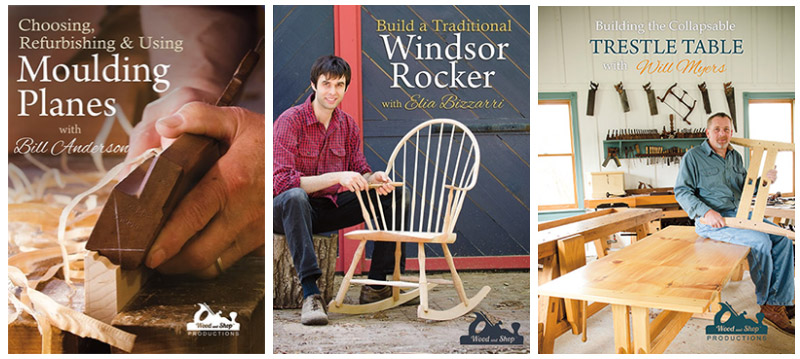
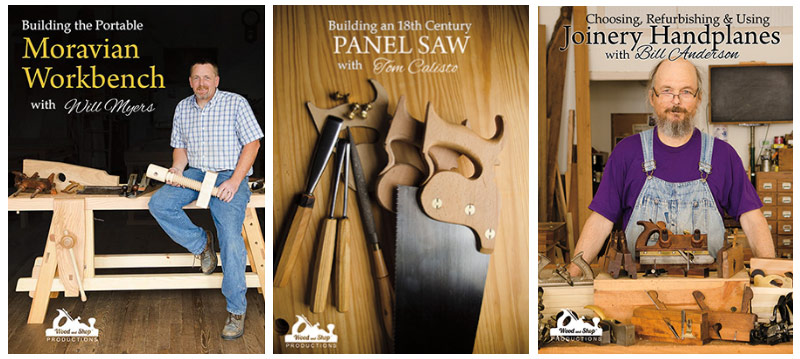
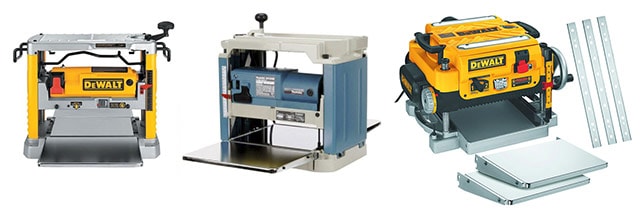
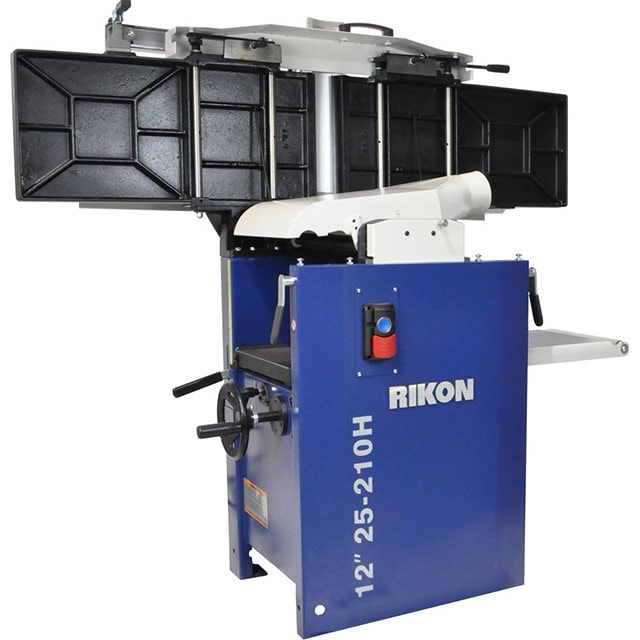
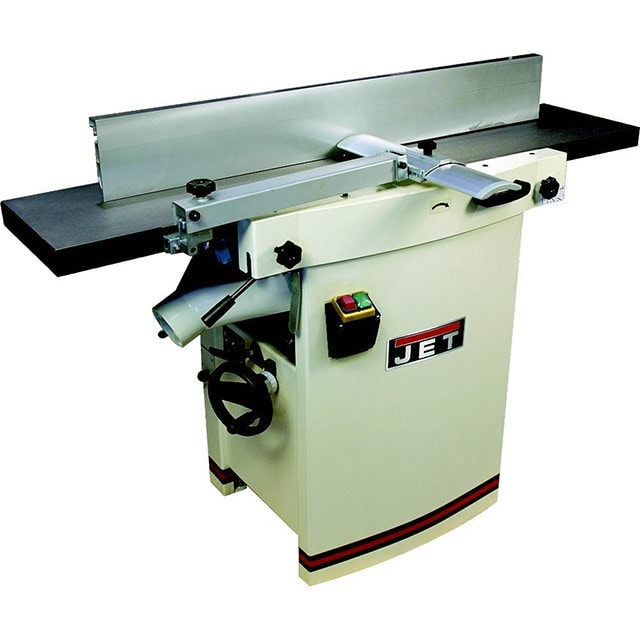
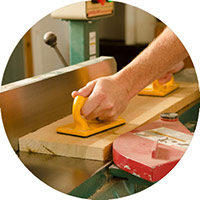
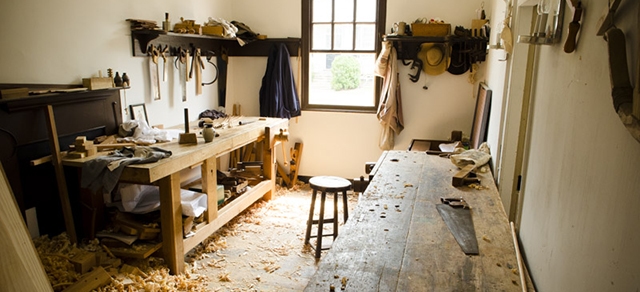
Very informative article. I’m looking to buy a planer(my first) and the information you provide is excellent. I am preparing one side of 1×12 heart pine to install in the interior of my barn. The lumber is rough cut and I only want it smooth enough to accept stain and finish on one side. I didn’t know I needed to run the wood through a jointer before using the planer. Is that necessary and why? Thank you very much for… Read more »
Hi Phillip. The jointer flattens the first face and edge. Then the newly flattened face runs on the base of the thickness planer. The thickness planer gives the board a uniform thickness.